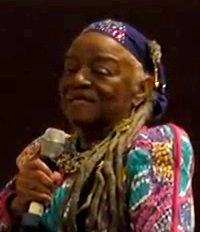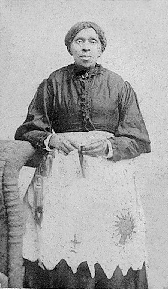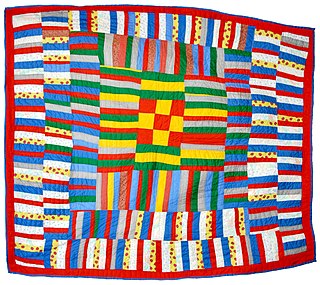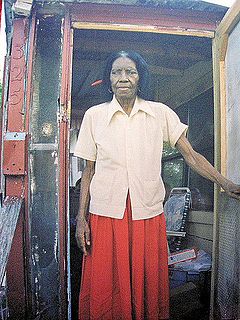Related Research Articles

The Philadelphia Museum of Art is an art museum originally chartered in 1876 for the Centennial Exposition in Philadelphia. The main museum building was completed in 1928 on Fairmount, a hill located at the northwest end of the Benjamin Franklin Parkway at Eakins Oval. The museum administers collections containing over 240,000 objects including major holdings of European, American and Asian origin. The various classes of artwork include sculpture, paintings, prints, drawings, photographs, armor, and decorative arts.
African-American art is a broad term describing the visual arts of the American black community. Influenced by various cultural traditions, including those of Africa, Europe and the Americas, traditional African-American art forms include the range of plastic arts, from basket weaving, pottery, and quilting to woodcarving and painting.

Faith Ringgold is a painter, writer, mixed media sculptor and performance artist, best known for her narrative quilts.

Harriet Powers was an American folk artist, and quilt maker. She was born into slavery in rural Georgia. She used traditional appliqué techniques to record local legends, Bible stories, and astronomical events on her quilts. Only two of her quilts are known to have survived: Bible Quilt 1886 and Pictorial Quilt 1898. Her quilts are considered among the finest examples of nineteenth-century Southern quilting. Her work is on display at the National Museum of American History in Washington, DC, and the Museum of Fine Arts in Boston, Massachusetts.
Cuesta Benberry was an American historian and scholar. Considered to be one of the pioneers of research on quiltmaking in America, and was the pioneer of research on African-American quiltmaking. Her involvement in quilt research spans from founding and participating in various quilt groups, to writing articles in renowned quilt magazines and journals. As a quilt scholar, Benberry acquired a collection of important quilts dating from the late 19th century up to the 21st century, as well as an extensive collection of paper documents supplementing quilting exhibitions, books, articles and her personal research.

The quilts of Gee's Bend are quilts created by a group of women and their ancestors who live or have lived in the isolated African-American hamlet of Gee's Bend, Alabama along the Alabama River. The quilts of Gee's Bend are considered to be unique, and one of the most important African-American visual and cultural contributions to the history of art within the United States. Arlonzia Pettway, Annie Mae Young and Mary Lee Bendolph are among some of the most notable quilters from Gee’s Bend. Many of the residents in the community can trace their ancestry back to slaves from the Pettway Plantation. Arlonzia Pettway can recall her grandmother’s stories of her ancestors, specifically of Dinah Miller, who was brought to the United States by slave ship in 1859.
The Quilt Treasures Project is an oral history project that documents the stories of a number of notable individuals who were instrumental in moving the 20th Century Quilt Revival forward in some significant way. These individuals include:
The Great Lakes Quilt Center is Michigan State University Museum’s center of quilt-related research, education, and exhibition activities. While the museum, established in 1855, has long held significant collections, its focus of activities on quilt scholarship and education began with the launch of the Michigan Quilt Project at the museum in 1984. The Michigan Quilt Project not only spearheaded the documentation of the state's quiltmaking history, but also stimulated interest in strengthening the museum's quilt collection, upgrading its care, and expanding its use. As of 2008, the Michigan Quilt Project has collected documentation on over 9000 quilts in the state and the collection of quilts numbers over 700 with significant examples from Michigan and the Great Lakes region, examples of quilts from numerous African countries, major ethnographic collections of Native American quilts and Michigan African American quilts, and special collections assembled by Kitty Clark Cole, Harriet Clarke, Merry and Albert Silber, Deborah Harding, and Betty Quarton Hoard. The MSU Museum also houses two important collections developed by pioneering American quilt historians Cuesta Benberry and Mary Schafer.
Kyra E. Hicks is an author, quilter and quilt historian. She writes about African-American quilt history and encouraging quilt documentation. She has created story quilts, such as Black Barbie, which is in the permanent collection of the Fenimore Art Museum in New York City.

Joyce J. Scott is an African-American artist, sculptor, quilter, performance artist, installation artist, print-maker, lecturer and educator. Named a MacArthur Fellow in 2016, and a Smithsonian Visionary Artist in 2019, Scott is best known for her figurative sculptures and jewelry using free form, off-loom bead weaving techniques, similar to a peyote stitch. Each piece is often constructed using thousands of glass seed beads or pony beads, and sometimes other found objects or materials such as glass, quilting and leather. In 2018, she was hailed for working in new medium — a mixture of soil, clay, straw, and cement — for a sculpture meant to disintegrate and return to the earth. Scott is influenced by a variety of diverse cultures, including Native American and African traditions, Mexican, Czech, and Russian beadwork, illustration and comic books, and pop culture.
Souls Grown Deep Foundation is a non-profit organization dedicated to documenting, preserving, and promoting the work of leading contemporary African American artists from the Southeastern United States. Its mission is to include their contributions in the canon of American art history through acquisitions from its collection by major museums, as well as through exhibitions, programs, and publications. The foundation derives its name from a 1921 poem by Langston Hughes (1902–1967) titled "The Negro Speaks of Rivers," the last line of which is "My soul has grown deep like the rivers.
Pecolia Warner was an American quiltmaker.
Wini "Akissi" McQueen is an American quilter based in Macon, Georgia. Her artistic production consists of hand-dyed accessories and narrative quilts. Her techniques for her well-known quilts include an image transferring process. In her work, she tackles issues of race, class, society, and women.

Sarah Mary Taylor was an African American quiltmaker from Mississippi.
Tina Williams Brewer is an American quilting artist, recognized for story quilts about African American history. Brewer was born in Huntington, West Virginia. She graduated from the Columbus College of Art and Design. Brewer started in interior design and pottery, but moved to quilting in 1986, feeling it was more compatible with motherhood. She is currently based in Pittsburgh, PA and has served on the boards of the Associated Artists of Pittsburgh and Pittsburgh Filmmakers/Pittsburgh Center for the Arts.
Mary Lee Bendolph is an American quilt maker of the Gee's Bend Collective from Gee's Bend (Boykin), Alabama. Her work has been influential on subsequent quilters and artists and her quilts have been exhibited in museums and galleries around the country. Mary Lee uses fabric from used clothing for quilting in appreciation of the "love and spirit" with old cloth. Mary has spent her life in Gee's Bend and has had work featured in the Philadelphia Museum of Art as well as the Minneapolis Institute of Art in Minnesota.
Gwendolyn (Gwen) Ann Magee was an African-American fiber artist. Learning to quilt in the middle of her life, Magee quickly became known in the world of fiber art for her abstract and narrative quilts depicting the African-American experience. Her work can be found in the permanent collections of the Mississippi Museum of Art, the Museum of Mississippi History, the Michigan State University Museum, and the Renwick Gallery of the Smithsonian Museum of American Art, and has been exhibited internationally.

Sandra Sider is an American quilt artist, author, and curator. She holds a Ph.D. in comparative literature from University of North Carolina, Chapel Hill, specializing in Renaissance studies. She also holds an M.A. in art history from the New York University Institute of Fine Arts.
Lucinda Toomer was an American artist who worked in the African-American tradition of quiltmaking. Her quilts are known for their bold compositions, visual rhythm, and improvisational style. They were at the forefront of a surge of national recognition for the art form during the 1990s.
Arester Earl (1892–1988) was an African American quilter. Her quilts incorporated appliquéd, stuffed charms, vibrant colors, and fabric crosses arranged in patterns reflecting African spirituality and folklore.
References
- ↑ Che, Jenny (December 12, 2014). "Philadelphia Museum of Art to Show Two Centuries of Black Artists". Wall Street Journal.
- ↑ Taylor, Sarah Mary (March 11, 2020). "Mississippi Encyclopedia" . Retrieved March 11, 2020.
- ↑ Serrell, Allison (2001-12-19). "Ella King Torrey / Art Institute president's collections have a story to tell". SFGate. Retrieved 2020-08-09.